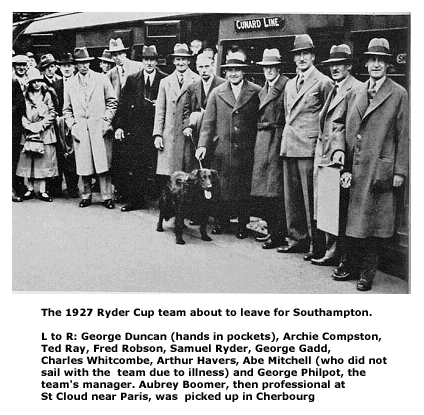|

George was engaged to report on the Ryder Cup matches and wrote in
his dispatches to the newspapers that he put the Americans’ victory
down to two factors. Firstly, he said: “They never missed a putt”
and secondly they had “mechanised the game”; in other words, they
had grooved repeating swings that stood up under pressure, not a
feature of the British game at that time. The record of the
Americans in our Open proved the point – from 1924 they had a run of
ten consecutive victories.
Al Watrous had recovered from his disappointment at Lytham and won
both his matches at Worcester. He partnered Gene Sarazen in a 3&2
victory over Havers and Jolly, then won his singles match with Fred
Robson by the same margin. He was a formidable match player, but the
fates that brought about his demise at Lytham were to visit him
again five years later. In the 1932 US PGA Championship Watrous was
nine up on the Scot Bobby Cruickshank after 24 holes of the 36-hole
match. On that 24th green he became complacent and conceded a
six-foot putt to his opponent. Thus reprieved Cruickshank began to
come back at the ill-fated Watrous and squared the match at the last
hole, then went on to win at the 41st. It was a classic case of
‘counting chickens before they are hatched’. Cruickshank, who hailed
from the Highland town of Grantown-on-Spey, did well on the US tour
between the wars and was runner-up to Bobby Jones in the 1923 US
Open. He later placed a $100 bet on Jones winning the Grand Slam in
1930 and was said to have collected $10,000. (The New York Times
reported that the actual winnings were $108,000!).
In 1928 my brother George travelled to Argentina with Arthur Havers,
to play in exhibitions and teach the enthusiastic Argentines. During
the trip they went to Cordoba to play in the Open, where George came
second. The Hurlingham Club course in Buenos Aires was co-designed
by George and Arthur. George was also to be involved in course
design at home and had a hand in revisions at some of his clubs,
including Wrexham and Malden.
 A series of articles by George appeared in a Sunday newspaper, each
dealing with a specific club and how it should be played. The series
also covered playing from rough, bunkers and hanging and uphill
lies. One article featured “an old favourite – a slice with the
putter”, a technique used by some leading golfers in those days,
including my brother Charles. Dai Rees, adopted the method early in
his career, when he was an assistant to George and had that
confidence of youth that enables you to just walk up to the ball and
knock it into the hole. He was using it when he made his debut in
the Ryder Cup in 1937. The only top line player to putt that way
these days is the American Billy Mayfair. A series of articles by George appeared in a Sunday newspaper, each
dealing with a specific club and how it should be played. The series
also covered playing from rough, bunkers and hanging and uphill
lies. One article featured “an old favourite – a slice with the
putter”, a technique used by some leading golfers in those days,
including my brother Charles. Dai Rees, adopted the method early in
his career, when he was an assistant to George and had that
confidence of youth that enables you to just walk up to the ball and
knock it into the hole. He was using it when he made his debut in
the Ryder Cup in 1937. The only top line player to putt that way
these days is the American Billy Mayfair.
NEXT
|